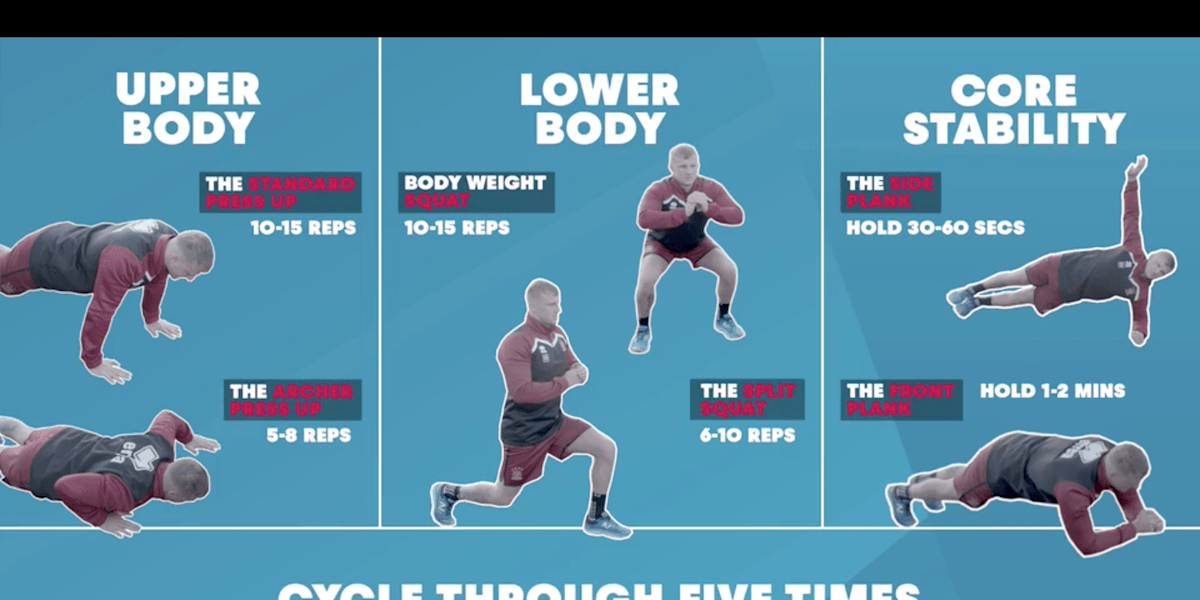
Forging the Rugby Warrior: A Comprehensive Guide to Fitness Training for Rugby Players
Rugby is more than just a game; it’s a brutal ballet of power, precision, and relentless endurance. To excel on the pitch, players must possess an extraordinary blend of physical attributes – strength to dominate scrums, power for explosive tackles, speed to break the line, agility to evade defenders, and the unwavering stamina to perform these actions repeatedly for eighty minutes. This isn’t a sport for the faint of heart or the underprepared. Fitness training for rugby players, therefore, must be as multifaceted and demanding as the game itself.
This comprehensive guide delves into the core components of a rugby player’s fitness regimen, outlining the "why" and "how" of developing the physical prowess required to become a true rugby warrior.
The Demands of the Game: A Multifaceted Athlete
Before dissecting the training methodologies, it’s crucial to understand the physiological demands rugby places on an athlete. A typical rugby match involves:
- High-intensity bursts: Sprints, tackles, rucks, mauls, lineouts, scrums – often at maximal effort.
- Repeated efforts: The ability to recover quickly from a high-intensity action and repeat it.
- Collision and impact: Constant physical contact, requiring robust strength and resilience.
- Aerobic and anaerobic energy systems: The game constantly switches between sustained low-intensity movement (aerobic) and explosive, high-intensity actions (anaerobic).
- Agility and change of direction: Evading opponents, supporting teammates, and reacting to play.
- Mental fortitude: Pushing through pain and fatigue, making critical decisions under pressure.
To meet these demands, a rugby player’s training program must be holistic, addressing strength, power, speed, agility, endurance, and mobility, all while prioritizing recovery and injury prevention.
1. Strength Training: The Foundation of Power and Resilience
Strength is the bedrock upon which all other physical attributes in rugby are built. It’s essential for winning collisions, dominating set pieces, and protecting the ball. Rugby players need both absolute strength (the maximum force they can exert) and functional strength (the ability to apply that strength in sport-specific movements).
Key Principles:
- Compound movements: Focus on exercises that engage multiple muscle groups simultaneously, mimicking natural movements.
- Progressive overload: Gradually increasing the resistance, repetitions, or sets over time to continually challenge the muscles.
- Periodization: Structuring training into phases (off-season, pre-season, in-season) with varying intensities and volumes to prevent plateaus and peak for competition.
Essential Exercises:
- Lower Body: Back Squats, Front Squats, Deadlifts (conventional, sumo, Romanian), Lunges (walking, reverse, lateral), Glute Ham Raises. These build powerful legs and glutes for scrummaging, tackling, and sprinting.
- Upper Body (Push): Bench Press (flat, incline), Overhead Press (standing, seated), Push-ups (weighted). Crucial for fending off defenders, driving in rucks, and tackling.
- Upper Body (Pull): Barbell Rows, Pull-ups/Chin-ups, Face Pulls. Develop back strength for rucking, mauling, and maintaining good posture during contact.
- Core: Planks (all variations), Russian Twists, Dead Bugs, Pallof Presses, Hanging Leg Raises. A strong core is vital for transferring power from the lower to the upper body, stabilizing the spine during collisions, and preventing injury.
Programming: Typically, 2-3 strength sessions per week, with a mix of heavy lifting (3-5 reps for strength) and moderate lifting (6-12 reps for hypertrophy and muscular endurance).
2. Power Training: The Explosive Edge
Power is the ability to generate maximum force in the shortest amount of time. In rugby, this translates to explosive acceleration, powerful tackles, dynamic jumps in the lineout, and driving forward in contact.
Key Principles:
- High intensity, low volume: Power exercises should be performed with maximal effort but with sufficient rest between sets to maintain quality.
- Technical proficiency: Proper form is paramount to prevent injury and maximize power output.
Essential Exercises:
- Plyometrics: Box Jumps, Broad Jumps, Depth Jumps, Medicine Ball Slams, Rotational Throws. These train the body to absorb and rapidly re-apply force.
- Olympic Lifts (under expert supervision): Power Cleans, Snatches, Jerks. These are complex but incredibly effective for developing full-body power and coordination.
- Kettlebell Swings: Excellent for developing explosive hip drive, crucial for tackling and driving.
Programming: 1-2 power sessions per week, often integrated into strength workouts or as standalone sessions, typically 3-5 sets of 3-6 repetitions.
3. Conditioning: The Engine Room
Rugby requires a finely tuned engine capable of both sustained effort and repeated high-intensity bursts. Conditioning training targets both the aerobic and anaerobic energy systems.
a) Aerobic Base:
While rugby is often seen as an anaerobic sport, a strong aerobic base is crucial for:
- Faster recovery: Improved cardiovascular efficiency allows players to recover more quickly between high-intensity efforts.
- Sustained effort: Maintaining a high work rate throughout the game.
- Off-season conditioning: Building a foundational level of fitness.
Training Methods: Long, steady-state runs (30-60 minutes at moderate intensity), cycling, swimming.
b) Anaerobic Conditioning & Repeated Sprint Ability (RSA):
This is where the game is often won or lost. RSA is the ability to perform multiple short, maximal sprints with minimal recovery.
Training Methods:
- Interval Training: Short bursts of maximal effort followed by brief recovery periods. Examples include 100m sprints followed by a walk back, or 30-second maximal efforts on a bike followed by 60 seconds of rest.
- Shuttle Runs: Running back and forth between cones over varying distances (e.g., 10m, 20m, 30m) with short rest.
- Game-Specific Drills: Incorporating conditioning into technical drills, such as continuous ruck pad drills, tackle bag circuits, or "Bronco" test variations.
- Small-Sided Games: Playing touch rugby or modified full-contact games with specific rules to emphasize continuous movement and high-intensity efforts.
Programming: 2-3 conditioning sessions per week, with a strong emphasis on RSA, especially during pre-season and in-season.
4. Speed & Agility: The Elusive Edge
Speed allows players to break away from defenders or close down attackers. Agility is the ability to change direction quickly and efficiently without losing balance or momentum, crucial for evading tackles or adjusting to the flow of play.
Key Principles:
- Technical focus: Proper running mechanics (arm drive, knee lift, posture) and change-of-direction technique are essential.
- Reaction time: Incorporating drills that require players to react to visual or auditory cues.
Training Methods:
- Speed: Short sprints (10-40m) focusing on acceleration, flying sprints (reaching top speed over a longer distance), resisted sprints (sled pulls), assisted sprints (downhill running).
- Agility: Cone drills (T-drill, Pro-Agility Shuttle), ladder drills, zig-zag runs, mirror drills (following a partner), reactive agility drills (e.g., chasing a coach’s directional signal).
Programming: 1-2 dedicated speed/agility sessions per week, often integrated into warm-ups or before power/conditioning work, performed when fresh to maximize quality.
5. Mobility & Flexibility: Injury Prevention and Performance Enhancement
Often overlooked, mobility and flexibility are critical for injury prevention, optimal movement patterns, and enhancing power output by allowing a greater range of motion.
Key Principles:
- Dynamic vs. Static: Dynamic stretching (movement-based) is for warm-ups, while static stretching (holding a stretch) is best post-workout.
- Consistency: Regular practice yields the best results.
Training Methods:
- Dynamic Warm-ups: Leg swings, arm circles, torso twists, walking lunges with a twist, glute activation drills.
- Static Stretching: Holding stretches for 20-30 seconds, focusing on major muscle groups (hamstrings, quads, hip flexors, glutes, chest, shoulders).
- Foam Rolling/Self-Myofascial Release: To address muscle knots and tightness.
- Yoga/Pilates: Excellent for improving core strength, flexibility, and body awareness.
Programming: Dynamic stretching before every session, static stretching and foam rolling post-session, and dedicated mobility work 1-2 times per week.
6. Nutrition & Hydration: Fueling the Machine
All the training in the world will be ineffective without proper fueling. Rugby players have high energy demands and require optimal nutrition for performance, recovery, and growth.
Key Principles:
- Carbohydrates: The primary fuel source. Prioritize complex carbs (whole grains, sweet potatoes, fruits, vegetables) before and after training/games.
- Protein: Essential for muscle repair and growth. Include lean protein sources (chicken, fish, lean beef, eggs, dairy, legumes) in every meal.
- Healthy Fats: Provide sustained energy and are crucial for hormone production. Avocados, nuts, seeds, olive oil are good sources.
- Hydration: Water is vital for performance. Dehydration significantly impairs physical and cognitive function. Drink water consistently throughout the day, especially before, during, and after training.
- Timing: Nutrient timing is important. Consume carbs and protein post-workout to kickstart recovery.
7. Recovery & Injury Prevention: The Unsung Heroes
Training hard is only half the battle; recovering effectively is the other. Without adequate recovery, players risk overtraining, fatigue, and injury.
Key Principles:
- Sleep: 8-10 hours of quality sleep per night is non-negotiable for physical and mental restoration.
- Active Recovery: Light cardio (e.g., cycling, swimming) on rest days to promote blood flow and reduce muscle soreness.
- Contrast Therapy: Alternating hot and cold showers/baths can aid recovery.
- Massage/Physiotherapy: Regular sessions can address muscle imbalances and tightness.
- Listen to Your Body: Recognize signs of overtraining (persistent fatigue, decreased performance, irritability) and adjust training accordingly.
8. Position-Specific Nuances (Briefly)
While all rugby players need a strong general fitness base, there are subtle differences in emphasis:
- Forwards (Props, Hookers, Locks, Flankers, No. 8): Higher emphasis on absolute strength, static power (scrummaging), and repeated efforts in close-quarter contact.
- Backs (Scrum-Half, Fly-Half, Centres, Wingers, Fullback): Greater emphasis on explosive speed, agility, and repeated sprint ability, along with dynamic power for evasive running and kicking.
However, modern rugby demands that even forwards possess good speed and agility, and backs must be strong enough to make tackles and win collisions.
Crafting a Training Week (Example)
A typical pre-season training week for a rugby player might look like this:
- Monday: Strength (Lower Body Focus) + Core
- Tuesday: Conditioning (RSA) + Speed/Agility
- Wednesday: Active Recovery / Mobility Session
- Thursday: Strength (Upper Body/Full Body Power Focus) + Core
- Friday: Game-Specific Drills / Light Conditioning
- Saturday: Full-Contact Training / Practice Match
- Sunday: Complete Rest / Active Recovery
This is a template and should be adapted based on individual needs, coaching philosophy, and the phase of the season.
Conclusion: The Holistic Approach
Becoming a top-tier rugby player is a journey of relentless dedication and intelligent training. It requires a holistic approach that seamlessly integrates strength, power, conditioning, speed, agility, and mobility. Coupled with meticulous nutrition, strategic recovery, and a resilient mindset, this comprehensive fitness regimen will forge an athlete capable of withstanding the immense physical demands of the game and performing at their peak. Remember, consistency, proper technique, and listening to your body are paramount. Embrace the grind, and you will unlock your full potential as a rugby warrior.



